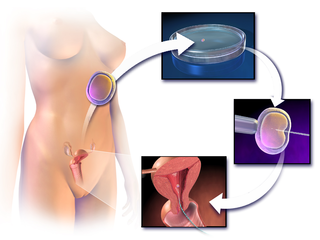
In vitro fertilisation (IVF) is a process of fertilisation in which an egg is combined with sperm in vitro. The process involves monitoring and stimulating a woman's ovulatory process, then removing an ovum or ova from her ovaries and enabling a man's sperm to fertilise them in a culture medium in a laboratory. After a fertilised egg (zygote) undergoes embryo culture for 2–6 days, it is transferred by catheter into the uterus, with the intention of establishing a successful pregnancy.

The Human Fertilisation and Embryology Authority (HFEA) is an executive non-departmental public body of the Department of Health and Social Care in the United Kingdom. It is a statutory body that regulates and inspects all clinics in the United Kingdom providing in vitro fertilisation (IVF), artificial insemination and the storage of human eggs, sperm or embryos. It also regulates human embryo research.

Assisted reproductive technology (ART) includes medical procedures used primarily to address infertility. This subject involves procedures such as in vitro fertilization (IVF), intracytoplasmic sperm injection (ICSI), cryopreservation of gametes or embryos, and/or the use of fertility medication. When used to address infertility, ART may also be referred to as fertility treatment. ART mainly belongs to the field of reproductive endocrinology and infertility. Some forms of ART may be used with regard to fertile couples for genetic purpose. ART may also be used in surrogacy arrangements, although not all surrogacy arrangements involve ART. The existence of sterility will not always require ART to be the first option to consider, as there are occasions when its cause is a mild disorder that can be solved with more conventional treatments or with behaviors based on promoting health and reproductive habits.
Embryo donation is one disposition option for users of in vitro fertilisation with remaining fresh or frozen embryos. It is defined as the giving—generally without compensation—of embryos remaining after in vitro fertilization procedures to recipients for procreative implantation or research. Most IVF users with supernumerary embryos make embryo donation decisions after completing their families or discontinuing use of in vitro fertilization. Recipients of embryos donated for procreative implantation typically plan to transfer fresh or frozen embryos into a prepared uterus in order to facilitate pregnancy and childbirth. Recipients of embryos donated for research typically use them for clinical training, quality improvement research, or human embryonic stem cell research.
Loizidou v. Turkey is a landmark legal case regarding the rights of refugees wishing to return to their former homes and properties.
Egg donation is the process by which a woman donates eggs to enable another woman to conceive as part of an assisted reproduction treatment or for biomedical research. For assisted reproduction purposes, egg donation typically involves in vitro fertilization technology, with the eggs being fertilized in the laboratory; more rarely, unfertilized eggs may be frozen and stored for later use. Egg donation is a third-party reproduction as part of assisted reproductive technology.

Eweida v United Kingdom[2013] ECHR 37 is a UK labour law decision of the European Court of Human Rights, concerning the duty of the government of the United Kingdom to protect the religious rights of individuals under the European Convention on Human Rights. The European Court found that the British government had failed to protect the complainant's right to manifest her religion, in breach of Article 9 of the European Convention. For failing to protect her rights, the British government was found liable to pay non-pecuniary damages of €2,000, along with a costs award of €30,000.
Barbora Bukovská is a Czech-Slovak human rights attorney and activist, known originally for her work on racial discrimination of Romani people in the Czech Republic and Slovakia, and later for free speech advocacy.

The Human Fertilisation and Embryology Act 1990 is an Act of the Parliament of the United Kingdom. It created the Human Fertilisation and Embryology Authority which is in charge of human embryo research, along with monitoring and licensing fertility clinics in the United Kingdom.
Sperm donation is the provision by a man of his sperm with the intention that it be used in the artificial insemination or other "fertility treatment" of one or more women who are not his sexual partners in order that they may become pregnant by him. Where pregnancies go to full term, the sperm donor will be the biological father of every baby born from his donations. The man is known as a sperm donor and the sperm he provides is known as "donor sperm" because the intention is that the man will give up all legal rights to any child produced from his sperm, and will not be the legal father. Sperm donation may also be known as "semen donation".
Von Hannover v Germany [2004] was a case decided by the European Court of Human Rights in 2004. The Court ruled that German law breached Article 8 of the European Convention on Human Rights.
Cryopreservation of embryos is the process of preserving an embryo at sub-zero temperatures, generally at an embryogenesis stage corresponding to pre-implantation, that is, from fertilisation to the blastocyst stage.
Natural Cycle In Vitro Fertilization (IVF) is an assisted reproductive technique designed to closely mimic a woman's natural menstrual cycle. In traditional IVF, a woman's ovaries are stimulated with fertility medications to produce multiple eggs, which are then retrieved and fertilized outside the body. A natural cycle IVF, on the other hand, works with the woman's natural hormonal fluctuations and ovulation cycle.
Partner-assisted reproduction, reception of oocytes from partner (ROPA), reciprocal IVF,shared motherhood, partner IVF or co-IVF is a method of family building that is used by couples who both possess female reproductive organs. The method uses in vitro fertilization (IVF), a method that means eggs are removed from the ovaries, fertilized in a laboratory, and then one or more of the resulting embryos are placed in the uterus to hopefully create a pregnancy. Reciprocal IVF differs from standard IVF in that two partners are involved: the eggs are taken from one partner, and the other partner carries the pregnancy. In this way, the process is mechanically identical to IVF with egg donation. Reciprocal IVF offers the highest chance for pregnancy and a lower chance of a multiple births.
The history of in vitro fertilisation (IVF) goes back more than half a century. In 1959 the first birth in a nonhuman mammal resulting from IVF occurred, and in 1978 the world's first baby conceived by IVF was born. As medicine advanced, IVF was transformed from natural research to a stimulated clinical treatment. There have been many refinements in the IVF process, and today millions of births have occurred with the help of IVF all over the world.
Forced fatherhood or imposed paternity, occurs when a man becomes a father against his will or without his consent. It can include deception by a partner about her ability to get pregnant or use of contraceptives, birth control sabotage, paternity fraud and sexual assaults of males that result in pregnancy.
E.S. v. Austria was a case held before the European Court of Human Rights (ECtHR) case where the court upheld a domestic court's fine on an Austrian woman who had called Mohammed a pedophile.

Roche v Roche [2010] 2 IR 321: [2009] IESC 82 is an Irish Supreme Court case which affirmed the High Court decision that frozen embryos did not constitute the “unborn” within the meaning of Article 40.3.3 of the Irish Constitution. The spirit of the Supreme Court's judgement was that frozen embryos were not extended the same right to life as given to embryos protected in the womb. With an increase in IVF among couples, legal issues arise when the couple decide to separate or divorce. This is a landmark case as it gave a judgement on such a circumstance where a couple has separated but there are surplus embryos frozen at a clinic. The Court made its decision by ultimately taking into account the right to reproduce.

James LePage, et al. v. The Center for Reproductive Medicine and Mobile Infirmary Association is a 2024 Alabama Supreme Court case in which the court reaffirmed that frozen embryos are considered a minor child for statutory purposes, allowing for in vitro fertilization (IVF) clinics to be held liable for the accidental loss of embryos under Alabama's Wrongful Death of a Minor statute, enacted by the Alabama legislature in 1872. In response, several IVF clinics in Alabama suspended operations.